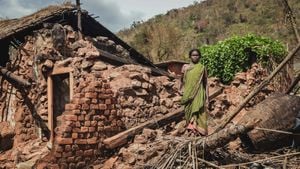Israeli aircraft made headlines last month as they reportedly launched strikes against Iranian targets, with significant focus on the destruction of what intelligence sources described as a covert nuclear facility known as Talegahn 2, located about 20 miles southeast of Tehran. These military operations carried out by Israel are said to have struck on October 26, showcasing the tension and hostilities still prevalent between these two countries. Sources from the U.S. and Israel claim the strikes did more than just target missile production and defense systems; they potentially dealt a severe blow to Iran’s nuclear ambitions.
Prime Minister Benjamin Netanyahu confirmed, "It’s not a secret. There is a specific component in their nuclear program" impacted by the strikes. He did not elaborate on the specifics but emphasized, as he spoke to the Knesset, the need to undermine Iran’s progression toward acquiring nuclear weapons. Repeatedly stating the urgency of halting Iran’s nuclear capabilities has become standard rhetoric for Netanyahu. He mentioned, "Their path to one is not completely blocked," reminding the audience of the protracted nature of Iran’s nuclear aspirations.
Israel's campaign against Iran has been prompted by several factors, including Tehran's backing of groups such as Hamas and Hezbollah and its consistent missile and drone strikes against Israeli territories. The October strikes followed nearly 200 ballistic missiles launched by Iranian forces targeting Israel, indicating the high stakes involved. Netanyahu's government launched its attack as retaliation for months of hostilities, which have reached new heights since the intensification of conflict with Hamas.
Initial reports suggested the Israeli forces targeted Iranian air defense systems and radars. But new reports indicate more aggressive aims, claiming the destruction of operational capabilities at the Talegahn 2 facility, previously believed to be inactive. The narrative shifted as intelligence analysis pointed to the site's use for secretive nuclear weapons research.
Even as Netanyahu celebrated the strikes as successful operations to hinder Iran’s military capabilities, Iranian officials sought to downplay the incident. Shortly after the attacks, Iran condemned the strikes, describing them as largely ineffective, stating they only resulted in minor damage—a communicative tactic aimed at preserving domestic morale.
Iran has historically maintained its nuclear program is for peaceful purposes, focusing on energy production and not weapons development. Yet, since the United States abandoned the Joint Comprehensive Plan of Action (JCPOA) back in 2018, Iran has ramped up its uranium enrichment efforts and now claims the capability to enrich uranium to weapons-grade levels. U.S. officials have also noted this worrying increase, highlighting the potential consequences if Iran were to reach 90 percent enrichment—a benchmark for developing nuclear weapons.
Adding to this complicated dynamic is the relationship between the U.S. and Israel. The United States has reiterated its support for Israel's right to self-defense, framing the situation as part of broader regional security concerns. A U.S. State Department official emphasized, "Iran should not respond to Israel's retaliation. If it chooses to do so, we will support Israel." This invokes the delicate dance of military strategy and diplomatic ties, especially as Israel engages with potential threats from Iran and its allies.
The ramifications of these airstrikes extend beyond military strategy. The regional response, especially from Iranian allies like Hezbollah, is under scrutiny. Hezbollah's continued rocket fire from Lebanon exemplifies the tangible risks involved as Israel navigates its responses. The strikes escalated tensions to unprecedented levels, marking over 3,481 casualties reported within Lebanon alone since the commencement of hostilities.
Meanwhile, the international response remains cautiously analytical. The Director General of the International Atomic Energy Agency (IAEA), Rafael Mariano Grossi, previously articulated concerns about the deteriorated space for diplomacy. "The fact international tensions exist shows the pathway to negotiation has become narrower rather than broader," he remarked during his recent trip to Tehran.
While the immediate outcomes of the Israeli strikes seem promising from their perspective, the long-term regional stability remains uncertain. The emphasis by Netanyahu on the need to eliminate Iranian military capabilities echoes louder. Still, the overlooked humanitarian toll and potential for retaliation pose significant challenges moving forward. Iran's capacity to retaliate, alongside its seeking nuclear prowess, introduces layers of complexity to already fraught relations.
Back at home, Israeli leadership's decisions must be closely monitored as public concern grows—especially considering the intense military exchanges witnessed and their consequences on domestic populations. The fear among citizens is palpable, with sirens regularly blaring as missiles cross borders.
Overall, Israel’s October strikes are positioned within the broader narrative of its defense strategy which views Iran as the primary threat, not merely to regional stability, but domestically as well. The government's approach indicates a shift toward increasingly proactive measures concerning national security. Yet, for all the military success proclaimed, significant gaps remain: the enduring vulnerabilities highlighted by international observers, and the potential backlash from Tehran could reshape the soon-to-be fragile security environment.
The strategic calculus for Israel appears complex, threading the needle of military might and international diplomacy, as it seeks to prevent Iranian militarization without igniting wider conflict—a scenario both local citizens and world leaders are carefully watching.



